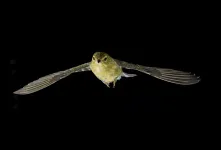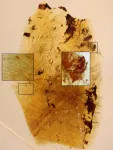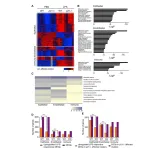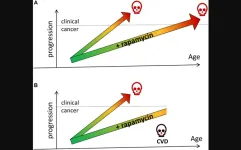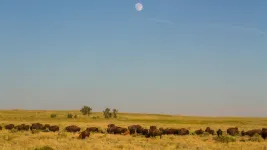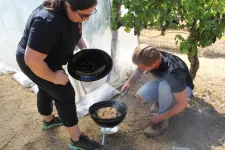(Press-News.org) AMHERST, Mass. – A team of scientists led by researchers at the University of Massachusetts Amherst has recently made a surprising discovery, with the help of a wind tunnel and a flock of birds. Songbirds, many of which make twice-yearly, non-stop flights of more than 1,000 miles to get from breeding range to wintering range, fuel themselves by burning lots of fat and a surprising amount of the protein making up lean body mass, including muscle, early in the flight. This flips the conventional wisdom on its head, which had assumed that migrating birds only ramped up protein consumption at the very end of their journeys, because they would need to use every ounce of muscle for wing-flapping, not fuel. The results appeared recently in the Proceedings of the National Academy of Sciences.
“Birds are amazing animals,” says Cory Elowe, the paper’s lead author and a postdoctoral researcher in biology at UMass Amherst, where he received his Ph.D. “They are extreme endurance athletes; a bird that weighs half an ounce can fly, non-stop, flapping for 100 hours at a time, from Canada to South America. How is this possible? How do they fuel their flight?”
For a very long time, biologists assumed that birds fueled such feats of endurance by burning fat reserves. And indeed, fat is an important part of migratory birds’ secret mix. “The birds in our tests burned fat at a consistent rate throughout their flights,” says Elowe. “But we also found that they burn protein at an extremely high rate very early in their flights, and that the rate at which they burn protein tapers off as the duration of the flight increases.”
“This is a new insight,” says Alexander Gerson, associate professor of biology at UMass Amherst and the paper’s senior author. “No one has been able to measure protein burn to this extent in birds before.”
“We knew that birds burned protein, but not at this rate, and not so early in their flights,” continues Gerson. “What’s more, these small songbirds can burn 20% of their muscle mass and then build it all back in a matter of days.”
To make this breakthrough, Elowe had help from the bird banding operators at Long Point Bird Observatory, in Ontario, along the northern shore of Lake Erie. Every fall, millions of birds gather near the observatory on their journey to their wintering grounds—including the blackpoll warbler, a small songbird that travels thousands of miles during its migration. After capturing 20 blackpolls and 44 yellow-rumped warblers—a shorter distance migrant—using mist nets, Elowe and his colleagues then transported the birds to the Advanced Facility for Avian Research at Western University, which has a specialized wind tunnel built specifically for observing birds in flight.
Elowe measured the birds’ fat and lean body mass pre-flight, then, when the sun set, let the birds free in the wind tunnel. Because the birds naturally migrate at night, Elowe and his colleagues would then stay awake—at one point, for 28 hours—watching for when a bird would decide to rest. At that point, the researchers would collect the bird and again measure its fat and lean body mass content, comparing them with the pre-flight measurements.
“One of the biggest surprises was that every bird still had plenty of fat left when it chose to end its flight,” says Elowe. “But their muscles were emaciated. Protein, not fat, seems to be a limiting factor in determining how far birds can fly.”
The researchers still don’t quite know why the birds are burning such vast stores of protein so early in their journeys, but the possible answers open up a wide range of future research avenues.
“How exactly is it possible to burn up your muscles and internal organs, and then rebuild them as quickly as these birds do,” wonders Gerson. “What insights into the evolution of metabolism might these birds yield?”
Elowe is curious about shivering—nonmigratory birds that overwinter in cold areas keep themselves warm by shivering. “This is also a feat of endurance,” says Elowe. “Do birds fuel their winter shivering spells the same way? And as the world warms, which method of coping with the cold—shivering or migrating—might be the better option for survival?”
Contacts: Cory Elowe, crelowe@umass.edu
Daegan Miller, drmiller@umass.edu
END
The surprising science behind long-distance bird migration
New research, led by UMass Amherst, shows that birds kick off their non-stop intercontinental flights with a protein boost
2023-04-17
ELSE PRESS RELEASES FROM THIS DATE:
Fossils reveal the long-term relationship between feathered dinosaurs and feather-feeding beetles
2023-04-17
New fossils in amber have revealed that beetles fed on the feathers of dinosaurs about 105 million years ago, showing a symbiotic relationship of one-sided or mutual benefit, according to an article published in Proceedings of the National Academy of Sciences of the United States of America today*.
The main amber fragments studied, from the Spanish locality of San Just (Teruel), contain larval moults of small beetle larvae tightly surrounded by portions of downy feathers. The feathers belonged to an unknown theropod dinosaur, either avian (a term referring ...
Sea-level rise in southwest Greenland as a contributor to Viking abandonment
2023-04-17
Vikings occupied Greenland from roughly 985 to 1450, farming and building communities before abandoning their settlements and mysteriously vanishing. Why they disappeared has long been a puzzle, but a new paper from the Department of Earth and Planetary Sciences (EPS) determines that one factor – rising sea level – likely played a major role.
“There are many theories as to what exactly happened” to drive the Vikings from their settlements in Greenland, said Marisa J. Borreggine, lead author of the “Sea-Level ...
SWOG researchers report results in rare gynecologic cancers from DART immunotherapy trial
2023-04-17
Results from the S1609 DART clinical trial, which tested an immunotherapy combination of ipilimumab plus nivolumab in 53 cohorts of patients with rare cancers, are being reported for five cohorts of patients who had rare gynecologic cancers.
In three of those five cohorts – the cohorts for clear cell ovarian cancer; small cell ovarian carcinoma, hypercalcemic type; and non-epithelial ovarian cancer – some patients have shown durable responses to the immunotherapy, including several patients whose complete remissions have now lasted more than three years.
The findings will be presented in three abstracts at the 2023 ...
Can you describe a sensation without feeling it first?
2023-04-17
Blind or colorblind people can describe colors and use expressions like “green with envy” or “feeling blue.” A hearing-impaired person can also say those same vibrant hues are “loud.” But many linguists and cognitive neuroscientists have assumed that somatosensation—touch, pain, pressure, temperature, and proprioception, or the sense of where your body is oriented in space—is fundamental for understanding metaphors that have to do with tactile sensations. Understanding expressions like “she is having a tough time” or “that class was hard,” it was believed, requires previous experience with those sensations to extend ...
p21 facilitates chronic lung inflammation via epithelial and endothelial cells
2023-04-17
“Our results implicate p21 as a critical regulator of chronic bronchitis and a driver of chronic airway inflammation and lung destruction.”
BUFFALO, NY- April 17, 2023 – A new research paper was published on the cover of Aging (listed by MEDLINE/PubMed as "Aging (Albany NY)" and "Aging-US" by Web of Science) Volume 15, Issue 7, entitled, “p21 facilitates chronic lung inflammation via epithelial and endothelial cells.”
Cellular senescence is a stable state of cell cycle arrest that regulates tissue ...
International clinical trial conducts head-to-head comparison of open versus minimally invasive surgery for early-stage cervical cancer
2023-04-17
COLUMBUS, Ohio – Gynecologic surgeons with The Ohio State University Comprehensive Cancer Center – Arthur G. James Cancer Hospital and Richard J. Solove Research Institute (OSUCCC – James) are leading an international clinical trial to determine whether minimally invasive surgery robotic surgery is better or worse than open surgery when performing a radical hysterectomy to treat cervical cancer.
Although minimally invasive and robotic-assisted surgery techniques have become the standard approach for many surgeries, in gynecologic cancer open surgery – which involves one ...
nPOD honors Estefania Quesada Masachs for type 1 diabetes discoveries
2023-04-17
LA JOLLA, CA—La Jolla Institute for Immunology (LJI) Instructor Estefania Quesada Masachs, M.D., Ph.D., has won the 2023 Young Investigator of the Year Award from the Network for Pancreatic Organ donors with Diabetes (nPOD). This prestigious award recognizes Quesada Masachs' groundbreaking research in type 1 diabetes.
Quesada Masachs says she was "happily surprised" to receive the award from nPOD at their 2023 conference. The organization provides pancreatic tissue samples to researchers, opening the door for in-depth research into type 1 diabetes, an autoimmune disease where the body's own immune ...
Cancer prevention with rapamycin
2023-04-17
“[...] long-term treatment with rapamycin slows down aging, a major risk factor for cancer [...]”
BUFFALO, NY- April 17, 2023 – A new research perspective was published in Oncotarget's Volume 14 on April 14, 2023, entitled, “Cancer prevention with rapamycin.”
The mTOR (Target of Rapamycin) pathway is involved in both cancer and aging. Furthermore, common cancers are age-related diseases, and their incidence increases exponentially with age. In his new research perspective, Mikhail V. Blagosklonny, M.D., Ph.D., from Roswell Park Comprehensive Cancer Center discusses rapamycin and other rapalogs and their ...
Temperature, drought influencing movement of Plains bison
2023-04-17
It epitomizes the Great Plains in spirit and in form: a 2,000-pound tank on hooves, cloaked in shaggy winter-tested coat, capped by horns acting as warning and weapon.
Even its scientific name, Bison bison bison, seems to conjure an echo worthy of its majesty. Still, the implacable profile of the Plains bison — the national mammal of the United States and largest on the continent — belies the vulnerability in its history, which saw its legions decimated from tens of millions to just a few hundred in the span of a few colonial centuries.
Conservation efforts have pushed its number back to roughly 20,000, and its status from endangered ...
Oregon State researchers make breakthrough in understanding the chemistry of wildfire smoke in wine
2023-04-17
CORVALLIS, Ore. – Oregon State University researchers have discovered a new class of compounds that contributes to the ashy or smokey flavors in wine made with grapes exposed to wildfire smoke.
This development is significant for winemakers who have struggled to combat the impact of smoke on grapes at a time when climate change is leading to an increase in the number and severity of wildfires, the researchers said.
“These findings provide new avenues for research to understand and prevent smoke taint in grapes,” said Elizabeth Tomasino, an associate professor of enology ...
LAST 30 PRESS RELEASES:
Drone sampling of whale breath reveals first evidence of potentially deadly virus in Arctic
Roman soldiers defending Hadrian’s Wall infected by parasites, study finds
Pinochet’s prisoners were tormented with music but still found solace in it, a new book reveals
Fertility remains high in rural Tanzania despite access to family planning
AI-assisted device can improve autism care access
Kinetic careers
Uncovering how parasitic plants avoid attacking themselves to improve crop resistance
Nanoparticle vaccine strategy could protect against Ebola and other deadly filoviruses
Study finds brain care score can predict risk of stroke across racial groups
Key lung immune cells can intensify allergic reactions
Do hormones explain why women experience more gut pain?
New materials conduct ions in solids as easily as in liquids
Breakthrough of the Year: Renewable energy begins to eclipse fossil fuel-based sources
LLM use is reshaping scientific enterprise by increasing output, reducing quality and more
Introducing LightGen, a chip for ultra-fast, ultra-efficient generative AI
Astronomers see fireworks from violent collisions around nearby star
ACC/AHA issue new guideline on managing congenital heart disease in adults
Cosmic crash caught on camera
Is talented youth nurtured the wrong way? New study shows: top performers develop differently than assumed
Ants: An untapped resource in the development of antibiotics?
Archaeologists use AI to create prehistoric video game
Mitochondria migrate toward the cell membrane in response to high glucose levels
Tiny viral switch offers hope against drug-resistant bacteria
Most parents aware of early peanut introduction guidelines, but confused about details
HPV vaccine can protect against severe lesions of the vulva and vagina
Virtual care provision and emergency department use among children and youth
Quadrivalent HPV vaccine and high-grade vulvovaginal lesions
Insights into dry eyes gained from stem cell-derived tear glands
Researchers identify 166 human pluripotent stem cell lines available for use in clinical applications
Europa Clipper instrument uniquely observed interstellar comet 3I/ATLAS
[Press-News.org] The surprising science behind long-distance bird migrationNew research, led by UMass Amherst, shows that birds kick off their non-stop intercontinental flights with a protein boost
